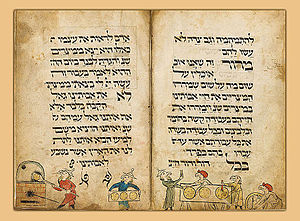| Birds' Head Haggadah | |
|---|---|
| Israel Museum | |
 | |
| Type | Illuminated manuscript |
| Date | c. 1300 |
| Place of origin | Southern Germany |
| Language(s) | Hebrew |
| Scribe(s) | Menahem |
| Material | Dark brown ink and tempera on parchment |
| Size | 27 by 18.2 centimetres (10.6 in × 7.2 in); 50 pages (originally) |
| Script | Block calligraphy |
| Contents | Haggadah for Passover, with accompanying illustrations |
| Previously kept | Owned by Ludwig Marum until 1933 |
| Discovered | Purchased by Israel Museum in 1946 |
The Birds' Head Haggadah (c. 1300) is the oldest surviving illuminated Ashkenazi Passover Haggadah. The manuscript, produced in the Upper Rhine region of Southern Germany in the early 14th century, contains the full Hebrew text of the Haggadah, a ritual text recounting the story of Passover – the liberation of the Israelites from slavery in ancient Egypt – which is recited by participants at a Passover Seder. The text is executed in block calligraphy and accompanied by colorful illustrations of Jews performing the Seder practices and reenacting Jewish historical events.
The Birds' Head Haggadah is so called because all Jewish men, women, and children depicted in the manuscript have human bodies with the faces and beaks of birds. Non-Jewish human faces and non-human faces (such as those of angels, the sun, and the moon) are blank or blurred. Numerous theories have been advanced to explain the unusual iconography, usually tied to Jewish aniconism. The Haggadah is in the possession of the Israel Museum in Jerusalem, where it is on permanent exhibition.